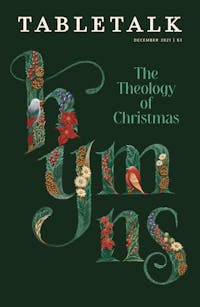
Request your free, three-month trial to Tabletalk magazine. You’ll receive the print issue monthly and gain immediate digital access to decades of archives. This trial is risk-free. No credit card required.
Try Tabletalk NowAlready receive Tabletalk magazine every month?
Verify your email address to gain unlimited access.
“What Child Is This?” is probably the most popular of the Christmas hymns written by William Chatterton Dix (1837–98). Its English folk tune “Greensleeves” helps. But its words also lead us to the heart of the Christmas story.
The hymn has a simple structure. The first two verses begin with questions about Jesus. The answers then lead to an exhortation to consecrate our lives to Him (verse 3).
The questions are fundamental: (1) Who is Jesus? (“What Child is this?”), and (2) What did He come to do? (“Why lies He in such mean estate?”). His identity and mission dominate the Bible story.
“what child is this?”
This question comes to the fore in various ways during the ministry of Jesus: “Who is he who forgives sins?” “Who is this that even the wind and the sea obey him?” “Who are you? Are you the Christ?” “Are you the King of Israel?”
Dix points us to two elements in the biblical answer. First, the Child is “Christ the King” (verse 1, line 5), a point Matthew emphasizes in the genealogy with which he opens his gospel: Jesus is “the son of David,” the long-promised Messiah who would sit on his throne. But His kingdom will have no end—He is “King of kings” (verse 3, line 3). This is why angels greeted His birth “with anthems sweet” (verse 1, line 3).
But why would Dix allow himself the poetic license to say that the shepherds “guard” Him (verse 1, line 6)? Because he knows, as Matthew again tells us, that another king, jealous of His crown, would soon seek to destroy Him (Matt. 2:13).

Second, the Babe is also “the silent Word,” “the Word made flesh” (verse 2, lines 3, 7). He is the eternal One who was pros ton theon (John 1:1), a Greek phrase that means “with God” or “toward God.” He who was face-to-face with God became flesh to be face-to-face with us. Only One who is truly God can reconcile us to God. Yet only One who becomes flesh can substitute for us. Wonder of wonders, One who was face-to-face with God and man, truly God and truly man, has come to save us. Is it any surprise that we are called to tremble with awe (verse 2, line 3)?
But why this sense of awe? The answer lies in Dix’s second question.
“why lies he in such mean estate?”
Verse 2 further explains this mystery of the Word made flesh. In verse 1, the Babe lies “on Mary’s lap.” But in verse 2, He lies “where ox and ass are feeding” (verse 2, line 2). He lies in a wooden manger, as though prophetic of the day when He would be stretched on a wooden cross and “nails, spear shall pierce him through, the cross be borne for me, for you” (verse 2, lines 5–6).
Here we are brought—at Christmastime—to the heart of the gospel: Christ died for us. Here Dix says verbally what Johann Sebastian Bach said musically in his Christmas Oratorio when he set the words “O LORD, how shall I meet thee, how welcome thee aright?” to the melody of “O sacred Head sore wounded, with grief and shame weighed down.” The stable points forward to the Place of the Skull; the manger makes sense only at the cross.
This is why the final verse bids us enthrone Christ in our hearts, give Him gifts that are fit for our King, and sing His praises during Advent season.
This Christmas hymn—like many others—has one major omission. There is no mention of Joseph, the man God entrusted with the care, protection, nurture, and education of the Word made flesh. Perhaps in Dix’s case this is significant. His father, a physician, was also, sadly, an alcoholic and abandoned the family when Dix was young, leaving all the attendant emotional scars. If this helps explain why Joseph is not present with shepherds, wise men, and Mary, nevertheless the hymn closes with a reminder that there is hope. For to all who trust Him, “the King of kings salvation brings” (verse 3, line 3). The Christ of Christmas offers Himself as an all-sufficient Savior to all who have needs, to all who feel lost and are without hope. Through faith in Him, they too can sing:
Joy, joy for Christ is born,
The Babe, the Son of Mary.
